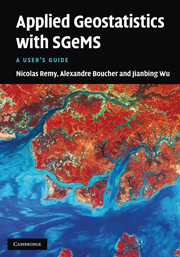Book contents
- Frontmatter
- Contents
- Foreword by Albert Tarantola
- Preface
- List of programs
- List of symbols
- 1 Introduction
- 2 General overview
- 3 Geostatistics: a recall of concepts
- 4 Data sets and SGeMS EDA tools
- 5 Variogram computation and modeling
- 6 Common parameter input interfaces
- 7 Estimation algorithms
- 8 Stochastic simulation algorithms
- 9 Utilities
- 10 Scripting, commands and plug-ins
- Bibliography
- Index
1 - Introduction
Published online by Cambridge University Press: 05 November 2011
- Frontmatter
- Contents
- Foreword by Albert Tarantola
- Preface
- List of programs
- List of symbols
- 1 Introduction
- 2 General overview
- 3 Geostatistics: a recall of concepts
- 4 Data sets and SGeMS EDA tools
- 5 Variogram computation and modeling
- 6 Common parameter input interfaces
- 7 Estimation algorithms
- 8 Stochastic simulation algorithms
- 9 Utilities
- 10 Scripting, commands and plug-ins
- Bibliography
- Index
Summary
SGeMS, the Stanford Geostatistical Modeling Software, is a software developed at Stanford University that implements several geostatistics algorithms for the modeling of earth systems and more generally space-time distributed phenomena. It was written with two goals in mind. The first one, geared toward the end-user, is to provide a user-friendly software which offers a large range of geostatistics tools: the most common geostatistics algorithms are implemented, in addition to more recent developments such as multiple-point statistics simulation. The user-friendliness of SGeMS comes from its non-obtrusive graphical user interface, and the possibility to directly visualize data sets and results in a full 3D interactive environment.
The second objective was to design a software that would cater to the needs of power-users. In SGeMS, most of the operations performed using the graphical interface can also be executed programmatically. The integrated support for the Python scripting language enables the creation of simple macros all the way to complete nested applications with an independent graphical interface. New features can conveniently be added into SGeMS through a system of plug-ins, i.e. pieces of software which can not be run by themselves but complement a main software. In SGeMS, plug-ins can be used to add new geostatistics tools, add new grid data structures (faulted stratigraphic grids for example) or define new import/export file filters. SGeMS is used as a development platform for geostatistics at the Stanford Center for Reservoir Forecasting (SCRF).
- Type
- Chapter
- Information
- Applied Geostatistics with SGeMSA User's Guide, pp. 1 - 4Publisher: Cambridge University PressPrint publication year: 2009



